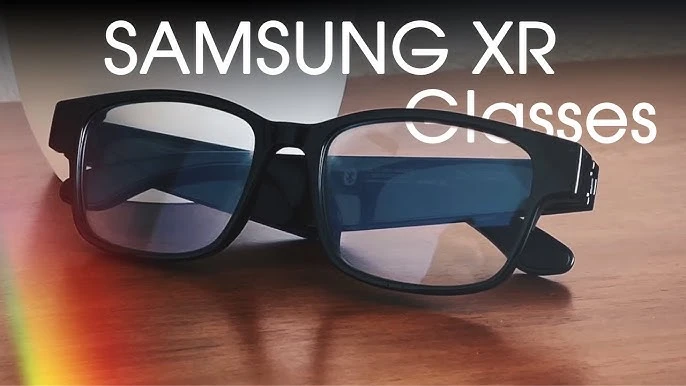Glimpse into the Future: What to Expect from Samsung’s XR Glasses
Extended Reality (XR) is rapidly evolving, and Samsung is poised to make a significant splash with its upcoming XR glasses. While the company has been a major player in the VR headset space for years, the new XR glasses promise a more integrated, everyday experience. Here’s a look at what we know so far and why the anticipation is building.

The Big Picture: A Collaborative Effort with Google and Qualcomm
Samsung isn’t going it alone in this ambitious venture. They’ve teamed up with tech giants Google and Qualcomm to bring their vision of XR to life. Google is heavily involved in developing the Android XR operating system that will power these devices, while Qualcomm’s Snapdragon XR chips are expected to provide the necessary processing power. This collaboration suggests a robust and well-supported ecosystem for the new glasses.
Launch Timeline: Patience is a Virtue
While earlier rumors hinted at a 2025 release, the latest reports suggest a full release for Samsung’s Android XR glasses in 2026. However, developers might get their hands on tools to start building for the platform by the end of 2025. This extended development time could mean a more refined and polished product upon launch.
Key Features: Smart, Seamless, and AI-Powered
The Samsung XR glasses are shaping up to be more than just a display on your face. Here’s a glimpse of the anticipated features:
- Galaxy AI Integration: Deep integration with Samsung’s “Galaxy AI” and Google’s Gemini AI model is a major highlight. This means intelligent assistance, real-time translations, memory recall (revisiting recent visual inputs), and enhanced navigation tools. Imagine asking your glasses for directions and seeing them overlaid on your real-world view, or getting real-time translations of a conversation.
- Lightweight and Stylish Design: Unlike bulkier VR headsets, Samsung’s XR glasses are aiming for a more discreet and comfortable form factor, potentially resembling regular eyewear. They are expected to weigh around 50 grams. Samsung is reportedly working with eyewear brands like Gentle Monster and Warby Parker on the design, suggesting a focus on aesthetics for everyday wear.
- Integrated Cameras, Microphones, and Speakers: These glasses will likely feature multiple cameras, microphones, and speakers for seamless interaction with your environment and smartphone. This will enable functionalities like hands-free calls, messaging, and photo capture.
- Optional In-Lens Display: While details are still emerging, an “in-lens display” is expected to privately provide information right when you need it, minimizing distractions while keeping you connected.
- Smartphone Synergy: The glasses are designed to work in tandem with your smartphone, giving you access to your apps and information without needing to pull out your phone.
- Qualcomm Power: The devices are expected to be powered by a Qualcomm chipset, likely the Snapdragon XR2 Plus Gen 2 processor, ensuring robust performance for XR experiences.
🔥 Leaked Features & Specs
1. Display & Optics
- Dual 4K Micro-OLED Panels (higher PPI than Vision Pro)
- 90Hz-120Hz Refresh Rate (for smooth motion)
- Pancake Lenses (slimmer than Fresnel lenses)
2. Performance & AI
- Samsung Exynos XR Chip (co-developed with Qualcomm)
- On-Device AI (real-time translations, object recognition)
- Hand & Eye Tracking (no controllers needed)
3. Design & Comfort
- Under 300g (lighter than Vision Pro’s 600g+)
- Adjustable Headband & Prescription Lens Support
4. Software & Ecosystem
- Android XR OS (optimized for Galaxy devices)
- Microsoft & Google App Support (Teams, YouTube, etc.)
- “Samsung Dex in AR” (floating multi-monitor setup)
🆚 Samsung XR vs. Competitors
| Feature | Samsung XR | Apple Vision Pro | Meta Quest 3 |
|---|---|---|---|
| Display | 4K Micro-OLED | 4K Micro-OLED | LCD (lower res) |
| Weight | <300g | 600g+ | 515g |
| OS | Android XR | visionOS | Meta OS |
| Price | $1,499+ | $3,499 | $499 |
Samsung XR Glasses Price
As of June 2025, Samsung has not officially announced the price for its upcoming XR glasses. However, there are strong indications and estimations from various sources:
- Expected to be lower than Apple Vision Pro: Most reports suggest that Samsung’s XR devices, including their Project Moohan headset and the rumored “Haean” and “Jinju” XR glasses, will be priced significantly lower than Apple’s Vision Pro, which launched at $3,499.
- Project Moohan Headset Estimates: Early predictions for Samsung’s XR headset (Project Moohan, which is a more immersive VR-like device than the glasses) have ranged from $1,000 to $3,000. Some sources hint at around $2,000 – $2,500.
- XR Glasses Likely Lower: The “XR glasses” (like Project Haean or Jinju) are expected to be more discreet and potentially less feature-rich than the full headset, leading to a likely lower price point.
- Competition with Meta: Samsung and Google are aiming to create a strong ecosystem for Android XR that competes with Meta’s offerings (like the Meta Quest 3, which starts around $499, and the Quest Pro, which launched at $1,500 and is now around $1,000).1 This suggests Samsung’s pricing strategy will be competitive within the XR market.
In summary, while there’s no concrete price yet, expect Samsung’s XR glasses to be a premium product, but likely more accessible than the Apple Vision Pro, potentially falling in the range of high-end smartphones or mid-range VR headsets. We’ll get a clearer picture closer to their anticipated release in 2026 (with developer tools possibly in late 2025).
Samsung XR Glasses Price in India
As of June 2025, Samsung has not officially announced the price of its upcoming XR glasses specifically for the Indian market.
However, we can infer some potential pricing and availability based on global information and typical Indian market trends:
- No Official India Price Yet: Since the global launch of the Samsung XR glasses (codenamed Project Haean or Jinju) is anticipated in 2026 (with developer tools possibly by late 2025), a specific Indian price will only be revealed closer to the actual launch.
- Likely a Premium Product: Given the advanced technology, AI integration (Galaxy AI, Google Gemini), and collaboration with Google and Qualcomm, these XR glasses will be a premium product.
- Lower than Apple Vision Pro: Globally, it’s widely expected that Samsung’s XR offerings will be more competitively priced than Apple’s Vision Pro (which launched at $3,499 in the US).1
- Headset vs. Glasses: It’s important to differentiate between Samsung’s more immersive XR headset (Project Moohan) and the sleeker XR glasses. The headset is expected to be more expensive. Some Indian tech portals have listed speculative prices for the “Samsung Project Moohan XR Headset” in the range of ₹2,09,999 to ₹2,99,999 as “upcoming.” The XR glasses, being a more everyday-wearable device, might be priced lower than the full headset, but still in the premium segment.
- Competition and Market Positioning: Samsung will likely position its XR glasses to compete with other smart glasses and AR devices in the Indian market, such as those from Xreal or potentially Meta’s Ray-Ban smart glasses (though these are generally simpler).2
- Import Duties and Taxes: When the product does launch in India, the price will include import duties, taxes (like GST), and other local costs, which can make electronic devices more expensive than their direct conversion from international prices.
In conclusion, while no concrete Indian price is available, expect the Samsung XR glasses to be a high-end consumer product, likely in the range of ₹1,00,000 to ₹2,50,000, but this is purely speculative until an official announcement. We will have to wait for Samsung’s official launch event in India to get the confirmed pricing.
Samsung XR Glasses Price Release Date
Release Date (Global & India):
Full Consumer Release: The most consistent information suggests that the full consumer release of Samsung’s Android XR glasses will be in 2026.
Samsung XR Glasses App
Here are some sleek and engaging Samsung XR Glasses app name ideas, tailored for different functionalities (gaming, betting, social, productivity, etc.):
General XR App Names
- Samsung XR Portal
- XR Vision by Samsung
- Galaxy XR Hub
- ImmersiVerse – XR Experience
- Samsung MetaView
Gaming & Betting Focus
- XR Bet Arena (for betting/sports)
- Click & Win XR (interactive betting)
- PulseBet XR (fast-paced wagering)
- Lucky Lens XR (AR casino/betting)
- XR Gambleverse (metaverse betting)
Social & Interactive Apps
- XR Connect – Meet in AR (social VR/AR)
- LiveSphere XR (virtual events)
- Samsung MetaChat (3D avatars chat)
- Glance – Social XR (quick AR interactions)
- PartyXR – Virtual Hangouts
Productivity & Utility
- XR WorkSpace by Samsung (virtual office)
- FocusLens – AR Productivity
- Galaxy XR Assist (AI-powered help)
- VisionSync – XR Organizer
- SmartView XR (multitasking in AR)
Futuristic & Cool Names
- NeoVision XR (cyberpunk-style)
- Quantum XR (high-tech feel)
- HoloCore – Samsung XR (holographic UI)
- OmniLens XR (all-in-one vision)
- ZeroLag XR (ultra-responsive)
Price and Competition: Eyeing the Market
While official pricing for the Samsung XR glasses is not yet available, they are expected to be positioned as a competitive alternative to high-end XR devices like Apple’s Vision Pro. Early estimates for Samsung’s related XR headset (Project Moohan) have hovered around $2,000, suggesting the glasses might also aim for a more accessible price point than Apple’s offering.
The XR market is heating up, with players like Meta (Ray-Ban Meta glasses) and Xreal also making strides. Samsung’s collaboration with Google and focus on AI-driven features could give them a strong edge in this competitive landscape.
✅ Potential Pros vs. ❌ Risks
| Pros | Cons |
|---|---|
| ✅ Lighter than Vision Pro | ❌ Late to market (2025) |
| ✅ Galaxy ecosystem integration | ❌ Fewer apps than Apple/Meta |
| ✅ More affordable than Apple | ❌ No confirmed launch date |
The Future is Clear (and Smart)
Samsung’s XR glasses represent a significant step towards a more integrated and intelligent future. With powerful AI capabilities, a focus on sleek design, and a strong collaborative foundation, these glasses have the potential to redefine how we interact with technology and the world around us. We’ll be keeping a close eye on further developments as the 2026 launch approaches!



